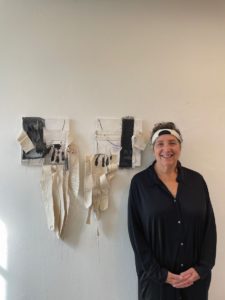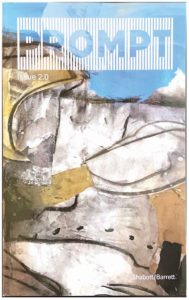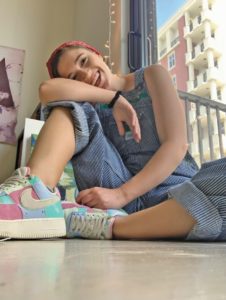“How can we use the element of contrast in our work?” asked Alana Barrett, one of the two founders of the art collective PROMPT at the beginning of last week’s Zoom meeting.

Answers began piling in rapid-fire as Barrett typed them into a PowerPoint slide.
“To add depth and dimension,” one member of the collective said. “Strong darks against strong lights,” added another.
“What’s that technique called?” Barrett prompted. “Chiaroscuro!” someone chimed in.
More responses followed: complementary colors, line quality, energy versus statis, geometric versus organic, the subject matter itself. Quickly, the slide filled up.
Barrett, who is based in Miami, then began to lecture about the 17th-century painter Artemisia Gentileschi. The collective maintained the same high level of enthusiasm for the duration of the meeting.
Laura Shabott, the other founder of PROMPT and a recent returning resident at the Fine Arts Work Center, has been a part of the Provincetown arts scene for longer than Barrett has been alive. According to Shabott, it is precisely the 40-year age gap that allows their skills to mesh so well as facilitators.
Their collaboration emerged in 2020 as a response to Covid when Shabott struggled to transition her art courses to Zoom. Barrett, whose mother was enrolled in Shabott’s class at the time and who had recently graduated from art school, came in to help Shabott figure out the technology requirements for virtual teaching. The two soon realized that their partnership had the potential to run deeper than logistics: Shabott and Barrett also got along as artists and educators, bringing different perspectives to the table.
Their three-year collaboration has inspired a flood of creation. Together they have taught 27 courses at the Provincetown Art Association and Museum and at Castle Hill and produced three publications. The collective has received organizational support from other institutions including the Fine Arts Work Center, Berta Walker Gallery, and Four Eleven Gallery.
Shabott says the goal of the collective is to “find our individual voices within a modernist context. PROMPT exists because this core group of people took a lot of classes with us, and we needed to evolve.”

At the height of the pandemic, they had about 45 people in regular attendance. “We shifted our relationship with people from ‘I’m going to teach you something you don’t know, and I’m responsible for making sure you know that’ to ‘We enjoy working together as a community. We are equals, and Alana and I are facilitators,’ ” says Shabott.
Once the new collective model was established, the group decided to create a print publication. Collating the work of member artists, including Shabott and Barrett, the zine — which Shabott calls “Alana’s baby” — put the collective’s work together in a physical form that could be shared with a wider audience. (PROMPT recently published its third issue, available for purchase on the collective’s website.) The publication is particularly influenced by painter Hans Hofmann’s compositional idea of “push and pull” and also draws inspiration from other artists including Robert Henry and Eva Hesse.
Shabott and Barrett have effectively managed to delegate the work that it takes to keep the collective thriving. Barrett handles the website and the design of their quarterly journal. She also manages Padlet, the app that the collective uses to share its work. Shabott’s responsibilities are more on the ground: she handles PROMPT’s finances and long-term planning in addition to keeping up with the Provincetown gallery scene. Both give lectures, conduct demonstrations, and critique members’ work.
The collective itself focuses on building community, studying art history, and making art. About half of its members live on the Outer Cape; the rest log in from all over the country. Shabott says that most of them are highly accomplished in other fields and that their participation in the collective represents a different kind of creative opportunity for them.

Later in last week’s meeting the group moved on to an analysis of Gentileschi’s paintings, paying particular attention to Susanna and the Elders. They noted how it depicted the power imbalance between genders. The collective, which is heavily female-identified, then discussed the rarity of successful female painters in Gentileschi’s era and speculated on the many challenges the artist likely faced — and marveled at the art she was nonetheless able to produce.
Moving on to a discussion of Gentileschi’s Judith Slaying Holofernes, one member wondered how its extreme contrast was possible in a time before electric lighting. Another raised questions about an ambiguous rectangle in the painting and asked others what they thought it might represent.
Gentileschi painted the Biblical story of Judith and Holofernes several times, which Shabott called “a testament to how you can learn so much as an artist by studying the same scene again and again.” Suddenly, there were only five minutes left in the meeting, and Barrett had to speed through her final few slides.
Editor’s note: An earlier version of this article, published in print on Sept. 29, incorrectly referred to the American impressionist painter and teacher Robert Henri instead of the Wellfleet painter and teacher Robert Henry. A subsequent correction, published on Oct. 6, wrongly referred to Henri as Parisian.



